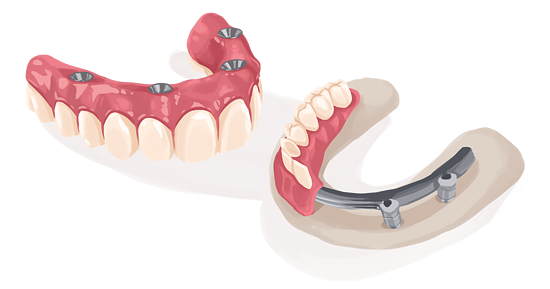The dental implant procedure is a big deal. You’re getting metal screwed into your jawbone and a new set of fake teeth placed in your mouth. It’s no surprise you’re looking to find out as much info about it as possible.
This article is tailored to be your comprehensive guide, unveiling the nuances of the dental implant process step-by-step providing you with the comprehensive insights you need before embarking on this transformative journey.
Are you a candidate for a teeth implant?
Dental implants are for people who are missing multiple teeth or are suffering from tooth decay.
Here’s a complete list of situations when you may very well be a good candidate for a teeth implant:
- If you’re missing multiple teeth
- If your jawbone is fully developed
- If you have enough bone to securely fuse with the implants
- If you have generally good oral health
- If you don’t have health problems that could jeopardize bone healing
- If you’re not able or not willing to wear dentures
- If speaking is too difficult
- If you’re willing to commit several months for the entire implant process
- If you don’t smoke tobacco or use tobacco products
Dental implant process step-by-step
Taking into consideration all of the stages and how long each could last, the whole dental implant procedure can take up to two years or longer.
Here’s a dental implant process step-by-step guide through the whole thing.
-
Initial consultation
The first thing you’ll do is meet with the dentist for the initial consultation. First, they’ll do a dental exam (which may include an X-ray and/or teeth impressions) to get a good idea of what they’ll be working with. Next, your dentist will come up with a treatment plan that includes the procedure steps, the timeframe for all of it, and what recovery will look like. If they think a bone graft is necessary, they’ll discuss that with you too.
-
Bone grafting
If you do need a bone graft, it could take 4-12 months after the graft before your jaw is ready and healed enough for the implants.
-
Dental implant placement
The next stage is the placement of the implants, which is a metal screw that’s inserted into your jaw bone. This is the anchor on which the whole prosthesis will sit. Placing the implants can take a couple hours, but you’ll be asleep the whole time.
-
Healing collar placement
After they place the implants, it can take up to five months for your lower jawbone to heal and seven months for the upper jawbone to heal. Once your bone is healed and has fused with the implants, you’ll get something called a healing collar. You may also need a temporary crown. The healing collar, a piece of round metal, goes on top of the implant and allows the gum tissue heal properly, keeping them from growing over the implant. The collar stays on for 10-14 days.
-
Abutment placement
Once your tissue is healed, the dental professional will remove the healing collar and place the abutment. This is the part that screws into the implant and on which will attach the crown. They’ll probably give you a temporary crown to wear for about 4-6 weeks while your custom-fit permanent crown is being made.
-
Crown placement
The last step in this process is to place the crown, which is the part that people will see, the part that looks like a real tooth. They will screw it onto the abutment and cement it in place.
Wondering how long does dental implant procedure take?
Taking into consideration all of the stages and how long each could last, the whole dental implant procedure can take up to two years or longer.

What to expect after dental implant surgery?
As with any oral surgery, you’ll most likely experience pain, swelling, maybe some bruising, and minimal bleeding.
First days after surgery
Directly after the surgery, your dentist will send you home with some instructions for the following 72 hours, including how to manage the symptoms. If the symptoms persist for a long time, speak with your dentist.
The following days
Following the surgery, you’ll want to treat your new teeth like you would natural teeth.
Go to your dentist on a regular basis, brush 2-3 times a day, floss, rinse with non-alcoholic mouthwash, don’t smoke cigarettes, or drink lots of alcohol. The implants are literally implanted into your bone, so they’re not going anywhere.
During your regular checkups, your dentist will also get X-rays of your mouth. What they’re looking for is how the implant, abutment, and crown are working well together.
Possible complications
There are some possible complications you should be aware of, like failed implant, infection, nerve damage, and sinus damage. But if you go to a reliable dentist, the likelihood of these things happening is less. Implants have an overall success rate of about 95%.
If everything goes well and you continue to take care of your implants as you would natural teeth, they can last as long as 25 years or longer.
Can the implant procedure be done better?
After meeting with you to prepare for the surgery, our team along with Dr. Golpa can place the implants and bridge in one visit.

We’ve improved upon the All-On-4 implant procedure and nearly perfected it, making it possible to get everything done in one visit. We use the best materials possible and make all customizations in-house.
Another key element when working with us is communication. We ensure you’re informed during every step of the process and do everything possible to make your experience as comfy and stress-free as we possibly can.
